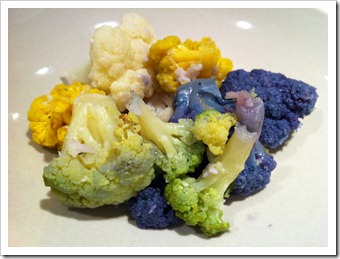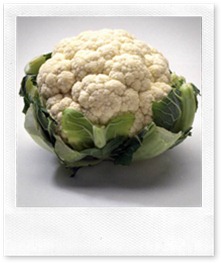Colorful Cauliflower
 I grew up believing that broccoli was just the name for green cauliflower. I now know better, but it turns out that my childhood associations weren’t too far from the truth! Among the various types of cauliflower, there is actually a green variety that looks kind of like broccoli and even has a name similar to broccoli – broccoflower.
I grew up believing that broccoli was just the name for green cauliflower. I now know better, but it turns out that my childhood associations weren’t too far from the truth! Among the various types of cauliflower, there is actually a green variety that looks kind of like broccoli and even has a name similar to broccoli – broccoflower.
Why Cauliflower?
You’re probably wondering why I’ve dedicated a whole post to a simple large ball-like vegetable. The fact is that vegetables are a key part of a low carb diet, and cauliflower is a useful vegetable to know about. When you puree boiled cauliflower, it forms a thick creamy texture that’s great as a thickening agent for soups and sauces. You can also use the puree by itself to make mashed cauliflower (if you add some butter) or cauliflower soup (if you add some chicken broth). In many cases, cauliflower can easily take the place of potatoes in recipes. Additionally, if you throw cauliflower into the food processor, then it forms small grain-like balls that are great for creating faux rice dishes (with a consistency much like couscous). Download the free recipe ebook for mashed cauliflower, cauliflower soup, faux rice, and other recipes. There’s so much that you can cook with just the white cauliflower. But now you can spice up your foods in a new way with all the colorful cauliflowers described below. Just think how cool purple mashed cauliflower will be!
Types of Cauliflower
You probably didn’t know this, but there are a huge number of different cauliflowers (way too many to list). Click here to see the full list. However, one can generally boil it down to 4 different colors of cauliflower:
White: The most common cauliflower is, of course, the white cauliflower that we generally see in the supermarkets. It’s a very nutritious vegetable despite not being green! One cup of cauliflower contains over 75% of your daily recommended amount of vitamin C and over 15% of vitamin K, and studies have even suggested that substances in cauliflower may prevent cancer. Click here to read the news report.
Purple: This rather uncommon cauliflower has such a great color that it’s easy to think it was dyed rather than naturally occurring. Its vibrant color comes from anthocyanin, which is an antioxidant that also causes red cabbages and red onions to be the colors that they are. Some website state that purple cauliflowers are a type of broccoli and that they will turn green when cooked, which can be true (although I haven’t witnessed it yet). Many cauliflower varietals are intermixed with broccoli varietals, and so some purple varietals will turn green when cooked, but other varietals will not. The purple varietal I have pictured above definitely did not turn green when cooked!
Orange: Yes, the colors get even more unusual. The orange cauliflower contains beta-carotene, which is an inactive form of vitamin A, and which is found in other vegetables such as carrots and sweet potatoes. This type of cauliflower was discovered in Canada back in the ‘70s and has since been crossbred with white cauliflowers to create the type that we see today. It has a slightly sweeter and creamier taste than the white variety.
Green: And, finally, we get to broccoflower, which can either be a cauliflower/broccoli hybrid or a mutant type of cauliflower where the white florets produce chlorophyll, which is the same substance that makes other plants green.
Vote Now
Vote for your favorite type of cauliflower below.
